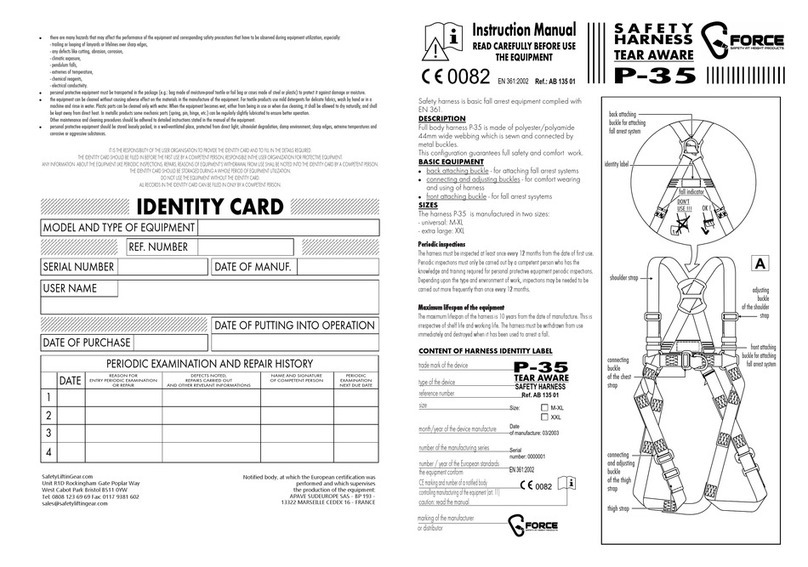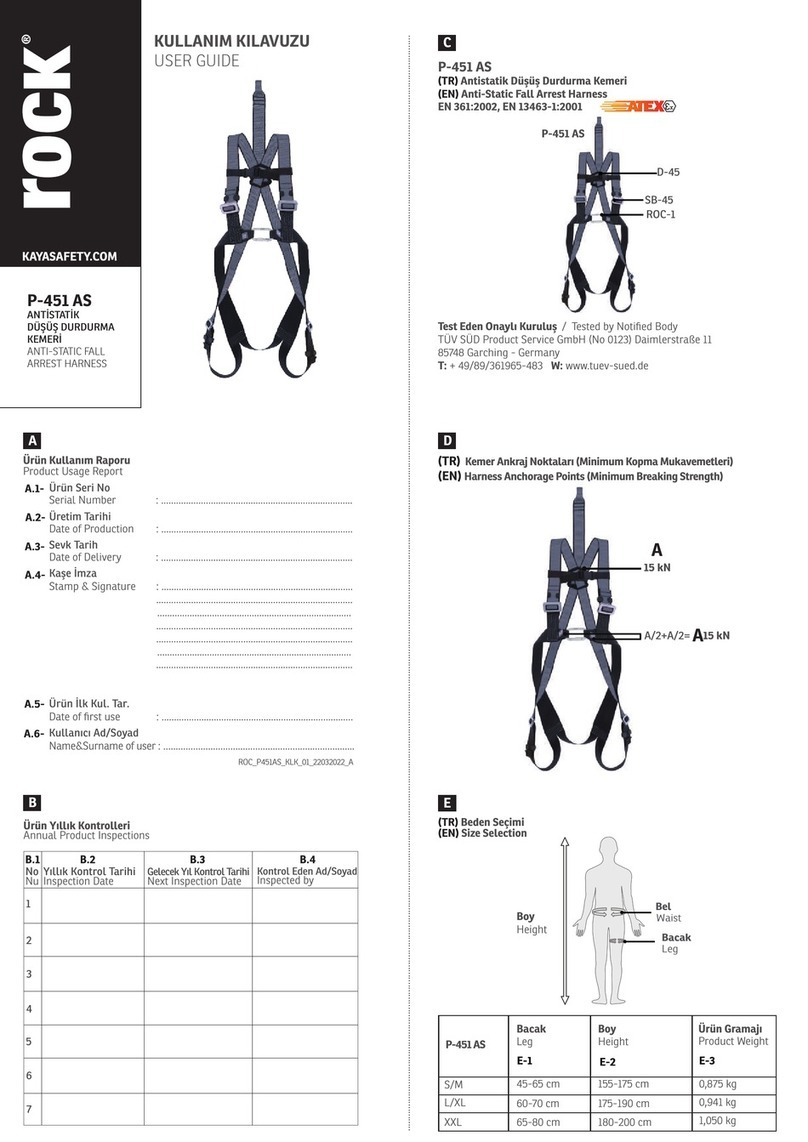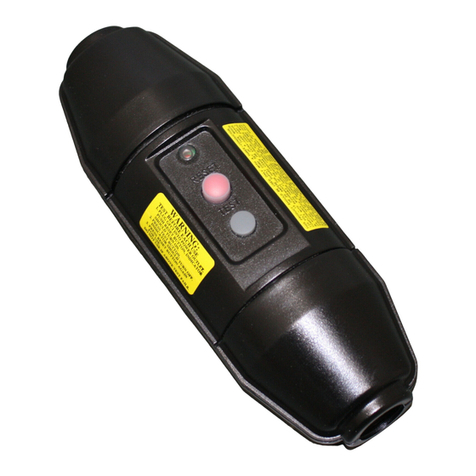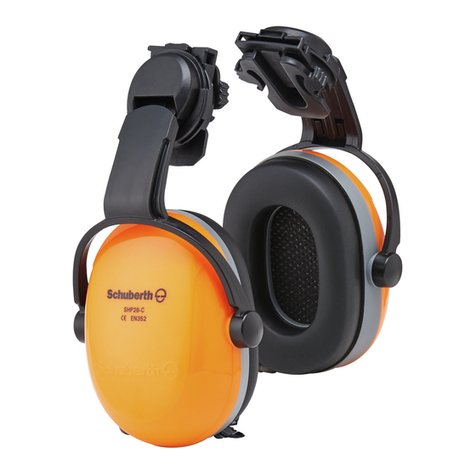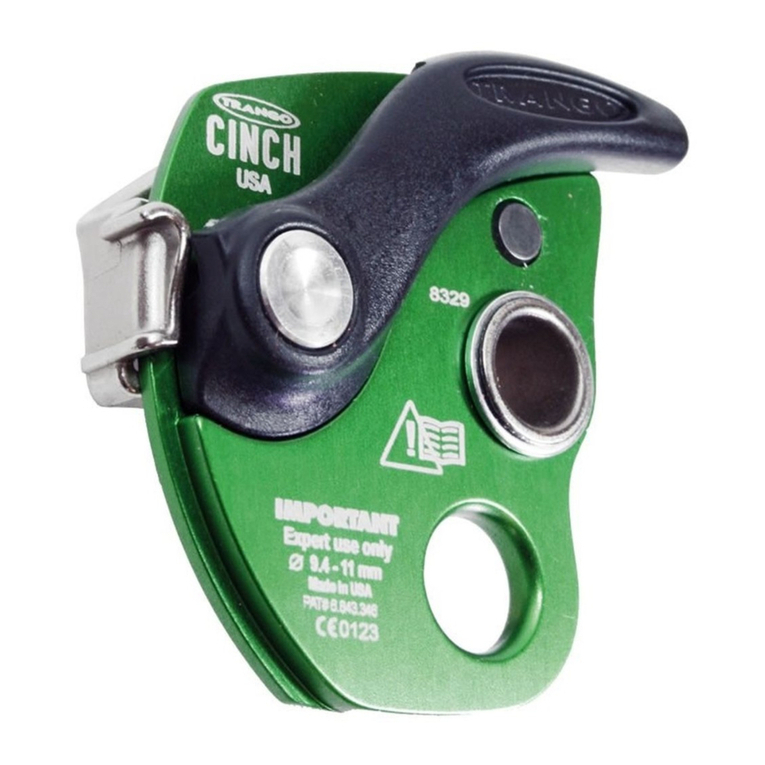
Symbool voor monturen
ST EN 166 F
Identificatieteken van de fabrikant
Nummer van deze norm
Symbool voor verhoogde mechanische vastheid / Bescherming
tegen deeltjes met grote snelheid / extreme temperaturen
Toepassingsgebied(en)
Symbool Omschrijving Omschrijving
Zonder Basistoepassing Niet-bepaalde mechanische risico‘s en gevaren
door ultraviolette, zichtbare en infrarode straling
en zonnestraling
3Vloeistoffen Vloeistoffen (druppels en spatten)
4Grof stof Stof met een korrelgrootte van > 5 μm
5Gas en fijn stof Gassen, dampen, nevel, rook en stof met een
deeltjegrootte van < 5 μm
8Vlambogen Vlambogen bij kortsluiting in elektrische instal-
laties
9Smeltend metaal en
hete vaste stoffen Spatten van smeltbaar metaal en doordringen
van hete vaste stoffen
Waarschuwingen: Brillenglazen van de optische klassen 3 zijn niet bedoeld voor langdurig
gebruik. Indien de symbolen F, B en A niet zowel voor het brillenglas als voor het montuur
gelden, dan moet voor het volledige oogbeschermingsmiddel de laagste graad worden toe-
gekend. Een oogbeschermingsmiddel komt overeen met symbool 8 voor het toepassings-
bereik wanneer het voorzien is van een filter van beschermingsklasse 2-1,2 of 3-1,2 en met
een brillenglas met een minimumdikte van 1,4 mm.
Een oogbeschermingsmiddel komt overeen met symbool 8 voor het toepassingsbereik
wanneer zowel het montuur als het brillenglas met dit symbool en met een symbool F, B of
A is gemarkeerd. Gekraste of beschadigde brillenglazen moeten worden vervangen. Oog-
beschermingsmiddelen tegen deeltjes met hoge snelheid kunnen - door de overdracht van
schokken - een gevaar inhouden voor de drager wanneer het oogbeschermingsmiddel over
een correctiebril wordt gedragen.
Wanneer bescherming tegen deeltjes met hoge snelheid bij extreme temperaturen nodig is,
dan moet het gekozen oogbeschermingsmiddel met letter T direct na de letter gemarkeerd
zijn met de letter voor de impactkracht, m.a.w. FT, BT of AT. Indien de letter T niet wordt
gevolgd door een letter voor de impactkracht, dan mag het oogbeschermingsmiddel alleen
bij kamertemperatuur tegen deeltjes met hoge snelheid worden gebruikt.
EN 172:1994 + A1:2000 + A2:2001 Zonnefilter voor bedrijfsmatig gebruik
Veiligheids-
niveau Toepassing Omschrijving
5-1,1
6-1,1
Dit beschermingsniveau geldt alleen voor
bepaalde fototrope zonnefilters in heldere
toestand en voor het meest lichtdoorlatende
bereik van verloopfilters.
5-1,4
6-1,4 Als heel heldere filter. Heel helder
5-1,7
6-1,7 Als heldere filter. Helder
5-2
6-2 Als aanbevolen universele filter, meestal goed
geschikt. Standaard
5-2,5
6-2,5 Meestal gebruikt in Centraal-Europa. Donker
5-3,1
6-3,1
In de tropen en subtropen, voor hemelobser-
vaties, in hooggebergtes, op sneeuwvlakken,
heldere watervlakken, zandvlakken, kalk- en
gipsgroeves.
Heel donker
5-4,1 Alleen bij extreme bestralingssterktes. Extreem donker
6-4,1
Fabrikant Jaar en maand van fabricage
Gebruiksaanwijzingen en informatie CE-markering
van de fabrikant lezen
EAC-markering UkrSepro-markering
plus aucune responsabilité concernant le produit après une réalisation incorrecte du netto-
yage. Une désinfection peut être effectuée avec un produit désinfectant doux.
Autres informations : Ce produit devrait être utilisé dans un délai de cinq ans à compter du
mois de fabrication désigné sur l‘étiquette.
Élimination : Éliminez ce produit avec les déchets ménagers. Après un contact volontaire
ou involontaire avec des produits chimiques, ce produit peut être pollué par des sub-
stances nocives pour l‘environnement ou dangereuses. Dans ce cas, l‘élimination doit être
effectuée en conformité avec la règlementation localement applicable.
Informations particulières : L‘EPI peut provoquer des réactions allergiques sur les person-
nes sensibles. Prudence particulière recommandée en cas de sensibilité connue.
EN 166:2001 Protection oculaire personnelle
Marquage des vitres
5 - 3,1 ST 1 F
Niveau de protection (pour filtres uniquement)
Marquage d‘identification du fabricant
Classe optique
Sigle de résistance mécanique
Niveau de protection (pour filtres uniquement) Coefficient Niveau de
protection
Filtre protecteur pour soudeur Sans 1,2 - 16
Filtre protecteur des UV (la reconnaissance des couleurs
peut être gênée) 2 1,2 - 5
Filtre protecteur des UV (bonne reconnaissance des couleurs) 2 C
Filtre protecteur des UV (bonne reconnaissance des couleurs) 3
Filtre protecteur des IR 4 1,2 - 10
Filtre de protection solaire (sans exigence IR) 5 1,1 - 4,1
Filtre de protection solaire (avec exigence IR) 6 1,1 - 4,1
Niveau de protection: Plus il est élevé et plus la perméabilité est réduite
(Degré de transmission).
Classe optique
Plus elle est basse, mieux c‘est. 1 - 3
Sigle de résistance mécanique Exigences de résistance mécanique
Sans Résistance minimum
S Résistance accrue
F Protection contre les particules à grande vitesse
(impact de faible énergie)
B Protection contre les particules à grande vitesse
(impact d‘énergie moyenne)
A Protection contre les particules à grande vitesse
(impact d‘énergie élevée)
FR
Instructions et informations du fabricant
Brochure d‘information sur les équipements de protection individuelle (EPI) conformément
au règlement (UE) 2016/425, annexe II section 1.4. Veuillez lire soigneusement cette bro-
chure d‘information avant l‘utilisation de l‘EPI. Vous êtes tenu de joindre cette brochure
d‘information en cas de transfert de l‘EPI, ou de la remettre au destinataire de l‘EPI. Cette
brochure d‘information peut être sans restriction reproduite à cet effet.
Protection oculaire personnelle Catégorie de risque II
Certification EN 166
Organisme notifié CERTOTTICA SCARL, Zona Industriale Villanova,
32013 - Longarone (BL), Italy
N° d‘identification 0530
Le marquage CE atteste que le produit répond aux exigences fondamentales en matière de
protection de la santé et de sécurité du Règlement (UE) 2016/425. La déclaration de con-
formité CE peut être consultée à www.storch.de/produktinfos/konformitaetserklaerungen.
Ce produit est un équipement de protection individuelle de la catégorie de risque II. Il
vous protège contre les risques suivants: Risques mécaniques, Risques visuels. Tous les
domaines d‘application autres que ceux susmentionnés sont expressément exclus. Ce pro-
duit n‘offre donc aucune protection notamment contre les risques suivants: Risques ther-
miques, Risques biologiques, Risques électriques. Merci de respecter les pictogrammes et
consignes apposés, et les niveaux de performances associés.
Entreposage/utilisation/contrôle : Stocker au frais et au sec. Tenir éloigné de la lumière
du jour directe, du rayonnement ultraviolet ou des sources d‘ozone. Ne pas entreposer à
l‘état plié ou sous une forte charge. Stocker et transporter le produit dans la mesure du
possible dans l‘emballage d‘origine. Les facteurs tels que la lumière, l‘humidité, la tempéra-
ture et les modifications naturelles du matériau pendant une période prolongée peuvent
occasionner une modification des propriétés du produit. Il est impossible de fournir des
indications précises sur la durée de stockage et la durée de vie de l‘ÉPI, car les deux
paramètres dépendent entre autres du type respectif de stockage, de la température, de
l‘humidité, du degré d‘usure et de l‘intensité d‘usage. Vérifiez par conséquent les dom-
mages ou modifications de matériau sur ce produit après un stockage prolongé, avant et
après chaque utilisation (par ex. revêtements/matériaux poreux, fissurés, trous, décolora-
tions, etc.). Vérifiez avant chaque utilisation l‘adaptabilité de ce produit à l‘activité prévue et
sa dimension adaptée. Les produits inadaptés ou défectueux doivent être éliminés et ne
doivent en aucun cas être utilisés. La dimension du produit peut diverger des indications,
par ex. par l‘allongement. Toutes les performances ont été déterminées par des essais en
conditions de laboratoire. Il est par conséquent recommandé de vérifier si l‘EPI est adapté
à l‘application prévue, car les conditions sur le lieu de travail peuvent être différentes en
fonction de différents paramètres (par ex. température, usure, intensité d‘usage) de celles
du contrôle de type. Si l‘EPI a déjà été utilisé, il peut offrir des performances moindres selon
le degré d‘usure. Le fabricant n‘assume aucune responsabilité en cas d‘utilisation incor-
recte du produit.
Nettoyage/Entretien : Le produit doit être nettoyé avec un chiffon humide (eau tiède, pro-
duit nettoyant doux), sans produits chimiques, puis laissé à sécher à l‘air libre. Vérifiez la
présence de dommages sur le produit après le nettoyage et avant de le porter à nouveau.
Ne pas réutiliser des produits endommagés. Selon le type de nettoyage, ce dernier peut
avoir un effet négatif sur la performance du produit. Le fabricant n‘assume par conséquent
Marquage de corps porteurs
ST EN 166 F
Marquage d‘identification du fabricant
Numéro de cette norme
Sigle pour une résistance mécanique accrue/Protection contre des
particules à haute vitesse/Températures extrêmes
Domaine(s) d‘utilisation
Sigle Désignation Description
Sans Utilisation de base Risques et dangers mécaniques indéfinis, engen-
drés par le rayonnement ultraviolet, visible et infra-
rouge, et par le rayonnement solaire
3Liquides Liquides (gouttes et projections)
4Poussière grossière Poussière d‘une granulométrie > 5 microns
5Gaz et poussière fine Gaz, vapeurs, brouillards, fumées et poussières
avec particules d‘une granulométrie < 5 microns
8Arc électrique parasite Arc électrique en cas de court-circuit dans des
installations électriques
9Métal fondu et corps
solides très chauds Projections de métaux fondus et pénétration de
corps solides très chauds
Mises en garde : Les vitres de classe optique 3 ne sont pas destinées à une utilisation lon-
gue durée. Si les symboles F, B et A ne valent pas aussi bien pour la vitre que pour le corps
porteur, il faut reconnaître le degré inférieur à l‘appareil de protection oculaire complet.
Afin qu‘un bouclier facial corresponde au symbole 8 pour le domaine d‘application, il faut
qu‘il soit équipé d‘un filtre offrant le niveau de protection 2-1,2 ou 3-1,2 et présentant une
épaisseur minimum de 1,4 mm. Afin qu‘un appareil de protection oculaire soit conforme au
symbole 8 pour le domaine d‘utilisation, il faut qu‘aussi bien le corps porteur que la vitre
arborent ce symbole avec l‘un des symboles F, B ou A. Les vitres rayées ou endommagées
doivent être remplacées.
Les appareils protégeant les yeux contre les particules à haute vitesse peuvent, du fait de
la communication des chocs, constituer un risque pour le porteur s‘ils sont portés sur des
lunettes habituelles équipées de verres correcteurs.
Si une protection contre les particules à haute vitesse est nécessaire à des températures
extrêmes, il faudrait que l‘appareil de protection oculaire arbore la lettre T marquée directe-
ment après la lettre qui représente l‘intensité de l‘impact, donc FT, BT ou AT. Si la lettre
caractérisant l‘intensité de l‘impact n‘est pas suivie de la lettre T, l‘appareil de protection
oculaire contre les particules à haute vitesse ne doit être utilisé qu‘à la température ambi-
ante.
EN 172:1994 + A1:2000 + A2:2001 Sunglare filters for industrial use
Niveau de
protection Utilisation Désignation
5-1,1
6-1,1
Ce niveau de protection ne vaut que pour cer-
tains filtres de protection solaire phototropes à
l‘état clair, et pour la zone de haute transmissi-
on de lumière des filtres progressifs.
5-1,4
6-1,4 Comme filtre très clair. Très clair
5-1,7
6-1,7 Comme filtre clair. Clair
5-2
6-2 Comme filtre universel recommandé, bien utili-
sable la plupart du temps. Moyen
5-2,5
6-2,5 Utilisé en majorité en Europe centrale. Foncé
5-3,1
6-3,1
Sous les tropiques et en zones subtropicales,
pour les observations du ciel, en haute
montagne, sur des surfaces enneigées,
des plans d‘eaux lumineux, des étendues
sableuses, des carrières de calcaire et de
craie.
Très foncé
5-4,1 Seulement en présence d‘intensités de
rayonnement extrêmes. Extrêmement foncé
6-4,1
Fabricant Année et mois de fabrication
Lire les instructions et informations Marquage CE
du fabricant
Marquage EAC Marquage UkrSepro
Smaltimento: smaltire il prodotto insieme ai rifiuti domestici. In caso di contatto acciden-
tale o intenzionale con prodotti chimici, questo prodotto può essere contaminato da sostan-
ze nocive per l‘ambiente o pericolose. In questo caso, lo smaltimento deve essere effettua-
to nel rispetto delle norme di legge locali.
Indicazioni speciali: i DPI possono causare reazioni allergiche nelle persone sensibili. In
caso di ipersensibilità nota si raccomanda una cura particolare.
EN 166:2001 Protezione personale per gli occhi
Codifica dei vetri
5 - 3,1 ST 1 F
Grado di protezione (solo per filtro)
Codice identificativo del produttore
Classe ottica
Sigla della resistenza meccanica
Grado di protezione (solo per filtro) Numero iniziale Grado di
protezione
Filtro protettivo per saldatore Senza 1,2 - 16
Filtro protettivo ultravioletti (può influire sul riconoscimento
dei colori) 2 1,2 - 5
Filtro protettivo ultravioletti (buon riconoscimento dei colori) 2 C
Filtro protettivo ultravioletti (buon riconoscimento dei colori) 3
Filtro protettivo infrarossi 4 1,2 - 10
Filtro solare (senza requisito infrarossi) 5 1,1 - 4,1
Filtro solare (con requisito infrarossi) 6 1,1 - 4,1
Grado di protezione: Quanto è maggiore, tanto minore è la permeabilità (Grado di trasmis-
sione).
Classe ottica
Quanto minore, tanto migliore. 1 - 3
Sigla della resistenza meccanica Requisiti di resistenza meccanica
Senza Resistenza minima
S Resistenza accresciuta
F Protezione contro particelle ad alta velocità
(impatto ad energia ridotta)
B Protezione contro particelle ad alta velocità
(impatto ad energia media)
A Protezione contro particelle ad alta velocità
(impatto ad energia elevata)
IT
Istruzioni e informazioni del produttore
Opuscolo informativo per i dispositivi di protezione individuale (DPI) ai sensi del regolamen-
to (UE) 2016/425, allegato II, sezione 1.4. Leggere attentamente questo opuscolo informa-
tivo prima di utilizzare i DPI. L‘utente è obbligato ad allegare questo opuscolo informativo al
momento della cessione dei DPI o di consegnarlo al beneficiario dei DPI. A tal fine, questo
opuscolo informativo può essere riprodotto senza limitazioni.
Protezione personale per gli occhi Categoria di rischio II
Certificazione EN 166
Luogo notificato CERTOTTICA SCARL, Zona Industriale Villanova,
32013 - Longarone (BL), Italy
Numero di identificazione 0530
Questo prodotto è un dispositivo di protezione individuale della categoria di rischio II. Pro-
tegge l‘utente nei seguenti casi: rischi meccanici pericoli ottici. Si escludono espressamente
campi di impiego diversi da quelli succitati. Questo prodotto non offre pertanto protezione
nei seguenti casi: pericoli termici, pericoli biologici, pericoli elettrici. Osservare i pittogrammi
allegati, le note e i livelli di prestazione corrispondenti.
Immagazzinamento / utilizzo / controllo: Conservare in un luogo fresco e asciutto. Tenere
lontano da luce solare diretta, raggi UV o fonti di ozono. Non immagazzinare piegato o sot-
to carico. Se possibile, immagazzinare o trasportare il prodotto nella confezione originale.
Influssi come luce, umidità, temperatura così come cambiamenti naturali del materiale,
durante un periodo più lungo, possono avere come conseguenza un cambiamento delle
proprietà del prodotto. Non sono possibili dati esatti per il tempo di immagazzinamento e la
durata dei DPI, poiché entrambi i parametri dipendono tra l‘altro dalle modalità di immagaz-
zinamento, dalla temperatura, dall‘umidità, dal grado di usura e dall‘intensità d‘uso. Con-
trollare che il prodotto non presenti danni o cambi di materiale (ad es. rivestimenti/materi-
ali screpolati, pieni di crepe, fori, cambiamenti di colore, ecc.) dopo un immagazzinamento
prolungato e prima e dopo ogni utilizzo. Prima di ogni utilizzo, verificare che il prodotto sia
adatto all‘attività prevista e sia di corrette dimensioni. I prodotti non idonei o difettosi devo-
no essere smaltiti e non utilizzati. Le dimensioni del prodotto possono differire dalle indi-
cazioni ad esempio a causa di allungamento. Tutte le prestazioni sono state determinate
mediante prove in condizioni di laboratorio. Si consiglia pertanto di verificare se i DPI sono
adatti all‘uso previsto, in quanto le condizioni sul posto di lavoro possono differire da quelle
della prova del modello di costruzione in relazione a vari parametri (ad es. temperatura,
abrasione, intensità d‘uso). Se i DPI sono già stati utilizzati, questi possono offrire prestazio-
ni inferiori a causa del grado di usura. Il produttore declina ogni responsabilità per qualsiasi
uso improprio del prodotto.
Pulizia / manutenzione: Il prodotto dovrebbe essere pulito con un panno umido (acqua
tiepida, detergente delicato) senza sostanze chimiche e asciugato all‘aria. Controllare che il
prodotto non sia danneggiato dopo la pulizia e prima di indossarlo nuovamente. Non riutiliz-
zare i prodotti danneggiati. A seco da del tipo di pulizia, questa può avere un effetto negati-
vo sulle prestazioni del prodotto. Il produttore non si assume pertanto alcuna responsabilità
per il prodotto dopo un‘errata pulizia. La disinfezione può essere eseguita con un disinfet-
tante delicato.
Altre indicazioni: questo prodotto deve essere utilizzato entro cinque anni dal mese di fab-
bricazione indicato sull‘etichetta.












